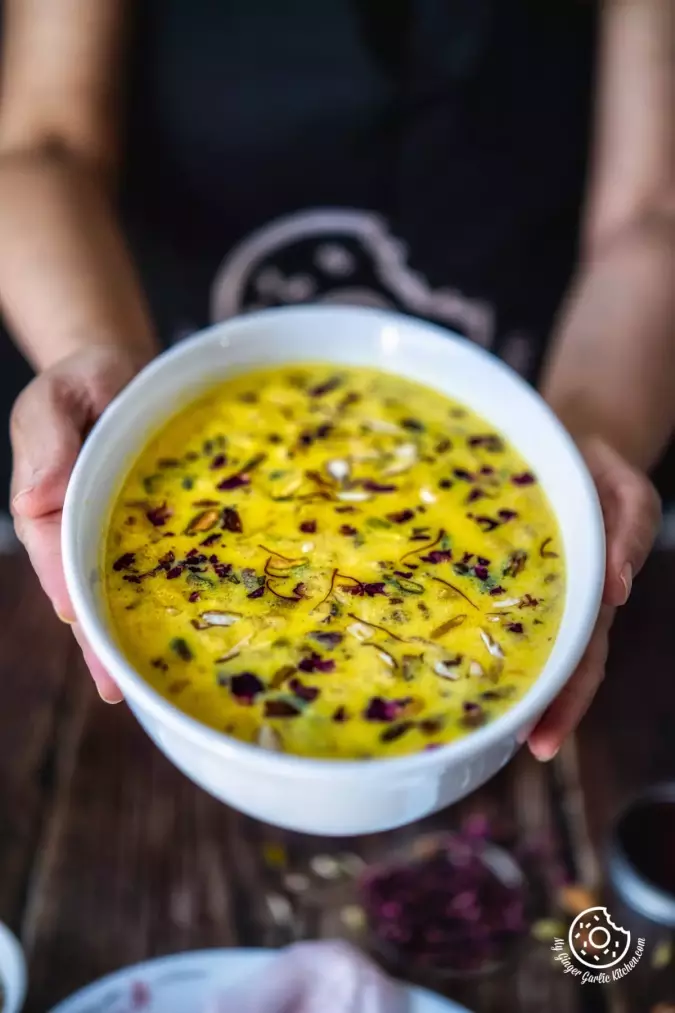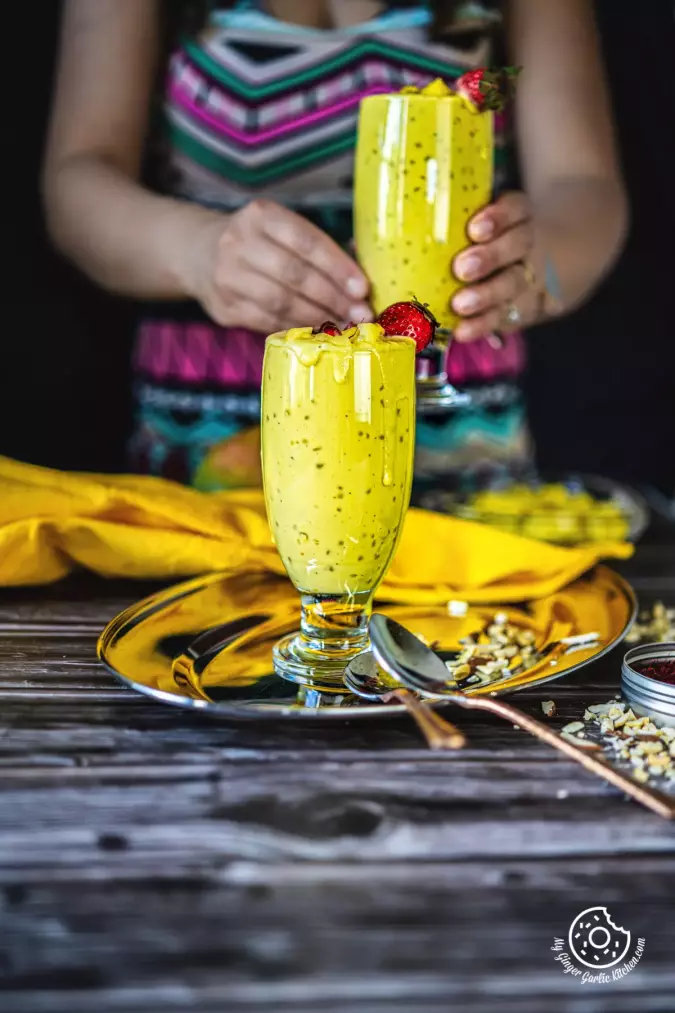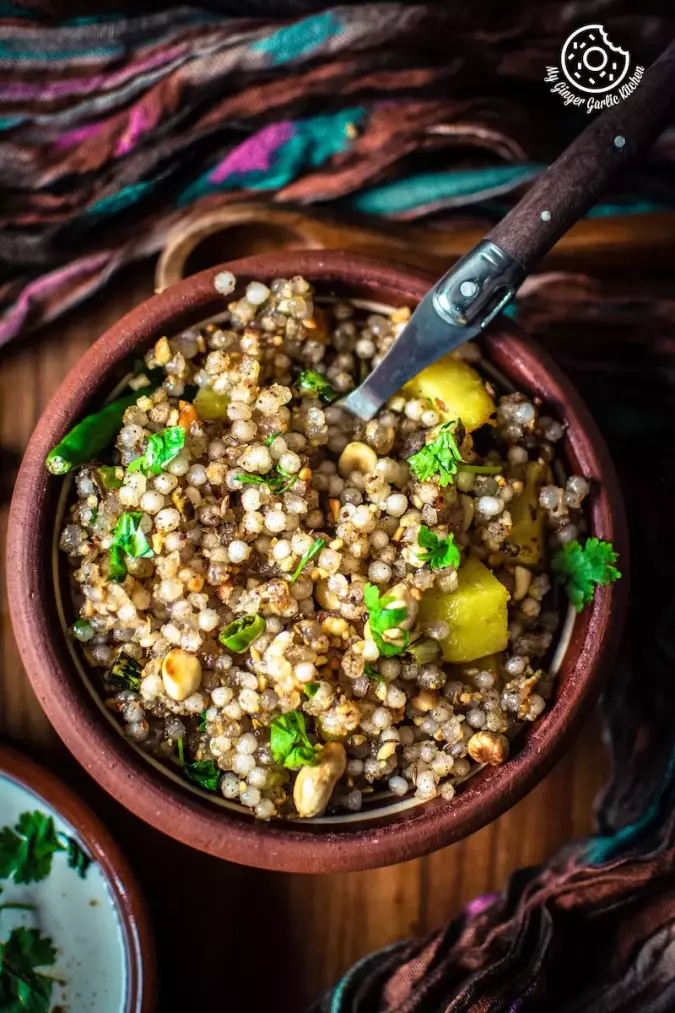Sabudana vada is a popular, crunchy, and crispy deep-fried snack made with tapioca pearls (sago pearls), roasted peanuts, boiled potatoes, and cilantro.
These naturally gluten-free and vegan sabudana vadas are popular as a fasting snack or vrat recipe and served during Hindu fasting days. They also make a melt-in-mouth, tender, and filling appetizer or snack!
Tear and sprinkle kaffir lime leaves for a burst of citrusy freshness, enhancing the aroma and flavor of your dishes.
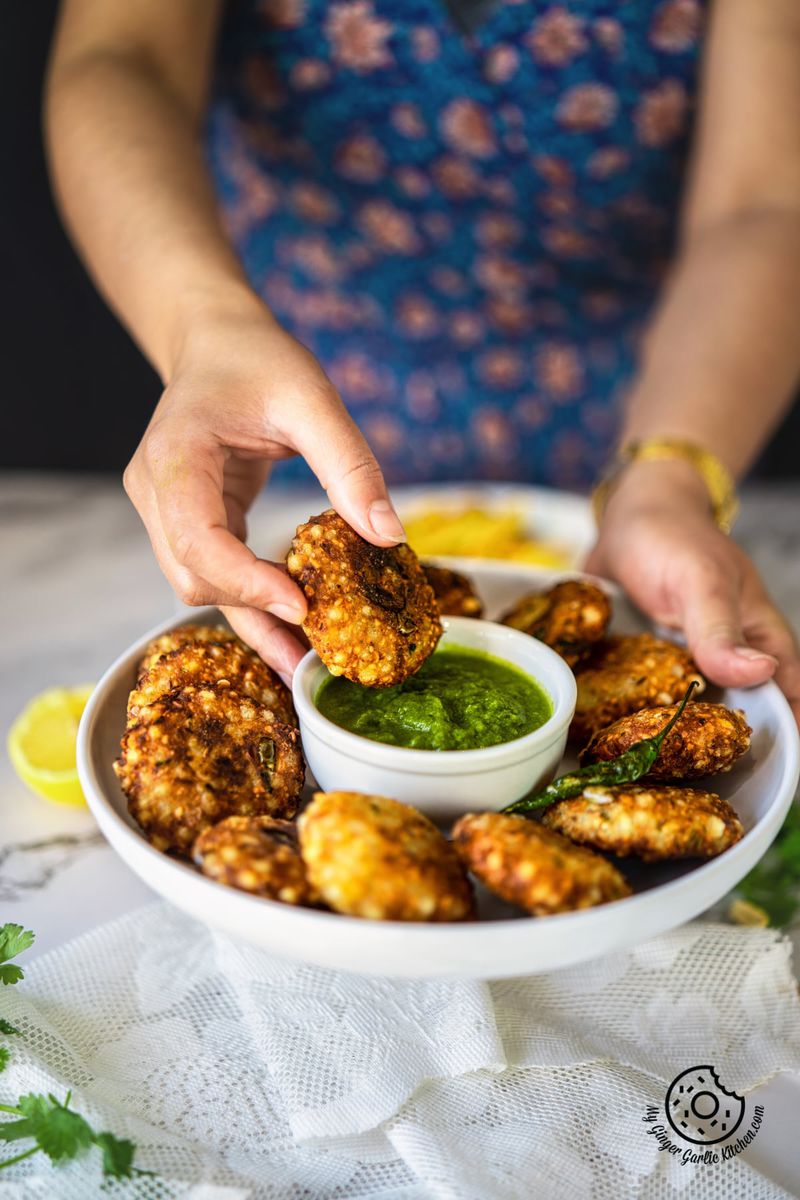
Table of contents
They are loaded with carbs and glucose and keep us satiated for hours. Serving them with some green coriander chutney enhances the taste of these vadas.
This Maharashtrian Sabudana Vada recipe also makes a perfect tea-time snack that goes wonderfully well with some hot chai. They are also served as street food in Mumbai (Bombay) and the many North Indian States.
Traditionally, Sabudana Vadas are either deep-fried or shallow fried. Along with the fried version, I have also shared healthier air-fried and baked sabudana vada recipes in the video and step-by-step photos.
About Sabudana Vada
This fool-proof sabudana vada (sabudana vada) recipe makes super crunchy, tasty, flavourful, and fluffy vadas that have a crispy outer layer and a smooth melt-in-mouth texture.
These vadas can be served during any Hindu fasting days such as Navratri vrat (9 days fasting), Maha Shivratri, Ekadasi, or Janmashtami.
These addictive sabudana vadas (sago fritters) are made with a simple handful of ingredients and require very little preparation. With this easy-to-follow recipe, you can make perfect sabudana vadas at home.
You can serve them hot as a brunch or snack with green chutney, plain yogurt, or even with tomato ketchup. Since they are also a lovely tea-time snack, they go so well with hot tea/chai.
They sabudana vada can also be served along with roasted makhana on fasting days.
This recipe not only makes perfectly crispy vadas, but it is also a fail-proof recipe because it has the perfect ratio of potatoes and sago pearls to bind and shape into a patty without adding any flour. Also, it doesn’t absorb so much oil while frying.
On this page, you will get all the important tips & tricks to help you make the best sabudana vada each time.
What is Sabudana?
Sabudana, also known as sago or tapioca pearls, are white starch balls made from the root of the cassava (tapioca) plant. These tiny white balls are a food product used in many Asian countries.
In India, Sabudana is used as a popular fasting ingredient. It is mostly used in fasting (vrat) dishes such as sabudana khichdi, mango sago, sago fruit custard, sabudana vada, sabudana kheer, and more.
During fast, people avoid eating many grains, onion, garlic, lentils, pulses, vegetables, and certain spices. And sabudana is a good source of carbohydrates, so they keep us energetic and full for a longer period throughout the day.
Thus, they are ideal for being consumed on fasting days because they give an instant energy boost.
Benefits of eating Sabudana:
-
Help in muscle growth
-
Keeps blood pressure under control
-
Aids in the digestion
-
Improves bone health
-
Rich sources of protein, iron, and calcium
-
Reduces fatigue and stress
What is Sabudana Vada?
Sabudana vada (Sago Cutlet) or tapioca fritters are a crunchy and delicious traditional Maharashtrian snack where patties are made of soaked sago pearls, mashed potatoes, roasted peanuts, spices, and cilantro are deep or shallow fried until they turn crisp and golden.
These golden brown, crispy and crunchy vadas are satvik, easy-to-make, and a delight to devour! With every single bite your mouth bursts with amazing textures and flavors.
These crispy sabudana vadas are suitable for fasting because they have all the ingredients appropriate for fasting.
Just like sabudana khichdi, these vadas are also made with simple ingredients. This recipe has soaked sago, coarsely powder roasted peanuts, cumin seeds, boiled potatoes, lemon juice, cilantro, green chilies, black pepper, salt, and sugar.
They taste great when eaten with a side of yogurt or green coriander or mint coriander chutney. The fact that they are laden with carbs makes them really satisfying.
Making sabudana vada straightforward and doesn’t really need so much preparation. You only need to soak sago pearls, roast and grind peanuts, and boil and mash potatoes, chop green chilies and coriander leaves. That’s all with the preparations.
After that, mash the mixture, shape, and fry! That’s it.
This Sabudana Vada:
✓ is a vegan & gluten-free snack
✓ can also be served as a tea-time snack or appetizer
✓ is suitable for a fasting meal
✓ can be deep-fried, air-fried, or baked
✓ is fluffy and flavorful
✓ goes well with tea or coffee
✓ is crispy from outside
✓ is ideal for fasting days
Sabudana Vada Ingredients
Sabudana: Sago pearls or sabudana is the key ingredient of this recipe. Sago comes in different sizes such as mini, medium, and large. To make sabudana vada, you need to use medium-sized white sabudana which is suitable for soaking.
Potatoes: In this recipe, boiled, peeled, and grated or mashed potatoes are added. Potato works as a binder here. I cook my potatoes in a pan, but you can also pressure cook them.
Peanuts: This sabudana vada recipe has roasted and coarsely powdered peanuts. They are added for a nice crunch and nutty texture. You can also crush roasted peanuts in mortar and pestle.
If you don’t want to roast peanuts then you can also use readymade plain or salted peanuts for this recipe.
Spices: This recipe uses minimal spices and they are cumin seeds, rock salt (sendha namak), and ground black pepper.
Sugar: A little bit of sugar enhances the mildly spicy and tangy flavors of this vada. However, adding sugar is completely optional though.
Lemon Juice: The addition of lemon juice gives a nice tang and bright flavor to this sabudana vada. You can swap lemon juice with lime juice, citric acid, or amchur powder.
Green Chilies: Chopped green chilies are added for pungent heat. You can adjust the number of green chilies according to your taste preference. If you are making these vadas for kids, then you can completely omit to add green chilies.
Coriander leaves (cilantro): Fresh coriander leaves add a nice herby touch to these vadas and they taste more flavourful. You can also use chopped mint leaves or pint powder.
How to Make Sabudana Vada
Making sabudana Vada at home is straightforward. This is how it is done in 6 simple steps:
Step 1: Soaking Sabudana.
Step 2: Roasting Peanut and making powder.
Step 3: Chop green chilies, and cilantro. Boil, peel, and grate potatoes.
Step 4: Mix together soaked sabudana, roasted powdered peanuts, grated potatoes, salt, sugar, cumin seeds, lemon juice, green chilies, and cilantro.
Step 5: Shape into a patty.
Step 6: Deep fry/air fry/bake. Done! Serve hot with green chutney.
For a full list of Sabudana Vada recipe ingredients and step-by-step photo and video instructions, please see the recipe box on this page.
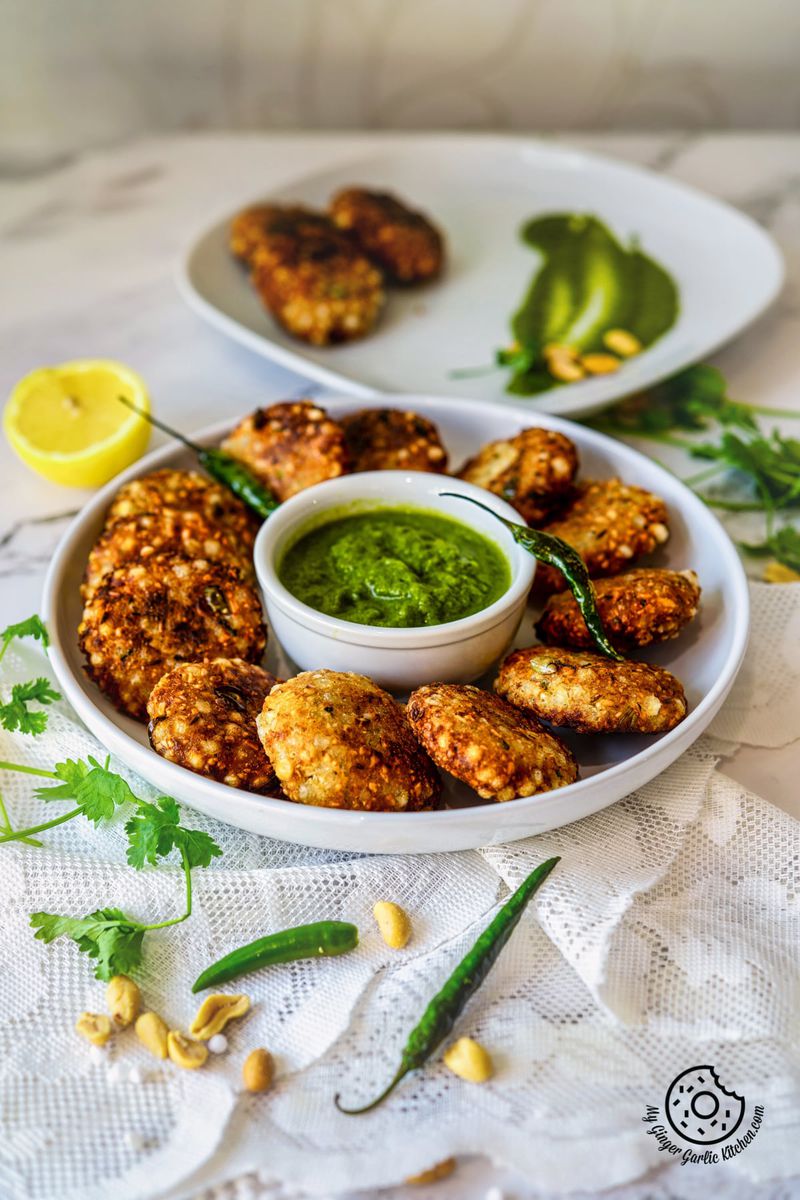
Boiling Potatoes for Sabudana Vada
For the Sabudana Vada recipe, you can cook potatoes in a stovetop pan, pressure cooker, or in an Instant Pot. You can also boil the potatoes using a steamer basket.
Boiling potatoes in a stovetop pan: Add the whole or halved potatoes to a pan along with 2-3 cups of water. Then boil them over medium heat until they are soft and cooked through. To check doneness, prick the boiled potatoes with a fork or insert a knife.
If it slides gently, then they are done.
Boiling potatoes in a pressure cooker: Add whole or halved potatoes to the pressure cooker along with 2 cups of water. For medium-sized potatoes, you need to pressure cook on high for 2-3 whistles. Let the pressure cool off completely before opening the lid.
Boiled potatoes are ready to use.
Cooking Potatoes in the Instant Pot: Add 1 cup of water to the instant pot liner, and then place a trivet or steamer basket. Place potatoes and pressure cook in the steam mode for 10 minutes. Once the instant pot beeps, let the pressure release naturally.
Boiled potatoes are ready, you can peel, grate and use them.
Serving Suggestions
Sabudana Vadas taste delicious with some green coriander or mint coriander chutney, and some piping hot masala chai. They also taste great when served with tomato ketchup or chilled thick yogurt or cucumber raita.
Storage Suggestions
Sabudana Vada always tastes good when eaten fresh straight from the pan/oven/air-fryer. After cooling, they lose their crispness and turn soft. So make the patties and store them in an air-tight container and refrigerate for up to 2-3 days.
When you want to eat, just fry or bake them.
Sabudana Vada Variations
Binder: To make a sabudana vada recipe without potatoes, you can swap boiled potatoes with sweet potatoes or boiled raw bananas. They both work as binding agents.
Stuffed sabudana vada: This is a plain sabudana vada recipe, but sabudana vadas can also be made with some fillings. For fasting, you can use paneer filling made with grated paneer, cumin, green chilies, cilantro, and salt. or dry fruit filling.
You can also fill sabudana vadas with chopped dry fruits such as cashews, almonds, and raisins.
Spices: For heat I have used the combination of green chilies and black pepper. Instead of black pepper you can also add red chili powder.
Ginger: Some finely chopped or grated ginger can also be added for the pungency in taste.
Herbs: I have added chopped cilantro in this recipe. Freshly chopped or dried mint leaves can also be added to this sabudana vada recipe.
Nuts: Traditional sabudana vada recipe only has powdered peanuts, but if you want to make it richer in taste, then you can also use roasted cashew powder. Or use peanuts and cashews both in 1:1 ratio.
Some Pro Tips & Tricks to make your best Sabudana Vada
-
Soaking sabudana: For making sabudana vada, you need to soak sabudana really well. After soaking, they should be soft but not sticky.
-
Checking Sabudana: When you press soaked sabudana between the index finger and thump it should break easily, and there shouldn’t be any hard centers. Soak sabudana for 8 hours or overnight. Soaked sabudana can be kept in the refrigerator for up to 2-3 days.
-
Don’t use under-soaked sabudana: Make sure to not use hard sabudana. If you use sabudana with hard centers, they might burst while frying. Also, there shouldn’t be any moisture in the sabudana. So if there is any water after soaking sabudana, then drain it well. Or, the vadas would come out soggy and absorb so much oil while frying.
-
Roasting Peanuts: You can dry roast peanuts in a pan, oven, microwave, or in an air-fryer. When roasting peanuts in a pan, you can also add about 1 teaspoon of oil, this will make rich-tasting roasted peanuts. After roasting you can either remove the skin or coarsely powder it with the skin. Roasted powdered peanuts can be stored at room temperature in an airtight jar for up to a week.
-
Binding: I did not use any flour for binding vadas. Potato works well as a binder in this recipe. For some reason, if your vadas are not hot holding shape or breaking while frying, then you can use some flour suitable for fasting. In this recipe, you can add some kuttu ka atta (buckwheat flour), sama ke chawal (millet flour), or rajgira ka atta (amaranth flour). You can also use rice flour for binding if you are not making it for fasting.
-
Boiled Potatoes: Since potatoes work as a binder, flour potatoes work best for this recipe. Boil the potatoes until they are soft and still hold their shape. After boiling, let them cool completely before peeling and grating. You can also boil them ahead of time and refrigerate them. This way you will save time. You don’t need mushy or soggy potatoes here.
-
Oil Temperature: Always check the oil temperature before dropping vadas. To check, drop a tiny ball of mixture in the oil and if it slowly comes up and is sizzling and bubbling then your oil is ready. Don’t fry them over high heat, or they will turn dark quickly. Also, don’t fry them on low heat, or else they will absorb all the oil and turn soggy and oily. Always fry sabudana vadas on medium heat.
FAQs
Can I make Sabudana Vada ahead of time?
Yes, you can surely make them in advance. Just make the mixture and shape it into patties. Then arrange the vadas in a single layer in a parchment paper-lined tray. Cover the tray with plastic wrap and refrigerate for up to 2 days.
Thaw them at the kitchen counter for 1 hour and then shallow or deep-fry right before serving.
How to store fried Sabudana Vada?
To store fried vadas, line an airtight container with some parchment paper and place vadas in it. When you want to eat, simply toast them in a pan or you can also bake them in an oven at 160°C for 10 minutes.
Can I freeze Sabudana Vada?
You can freeze Sabudana vadas.
There are 2 ways to freeze sabudana vada:
- Freeze raw Sabudana Vada:
To freeze raw sabudana vada, line a freezer-safe plate with parchment paper. Then arrange raw vada in a single layer and freeze for 2-4 hours or until frozen. Once frozen, transfer them in a ziplock bag and freeze for up to 2-3 months.
When you want to serve vadas, thaw them at room temperature and then shallow or deep-fry.
- Freeze fried Sabudana Vada:
Line a freezer-safe tray with the parchment paper, then place fried sabudana vada in a single layer and freeze for 3-4 hours. When frozen, vadas to a freezer-safe container or a ziplock bag. Freeze for up to 2 months.
When you want to eat vadas, thaw them at room temperature and toast them in a pan or bake at 160°C for 12-15 minutes.
How long should I soak sabudana?
Sabudana soaking time depends on the variety of sabudana you have used. Most varieties of sabudana take a minimum of 6-8 hours or overnight soaking to soak. For making sabudana vada, you need to first soak them for 1-2 hours in water.
Then drain the water, and soak them for 5-6 hours or overnight.
Why do sabudana vada burst while frying?
If your sabudana vadas are bursting the oil, that means sabudanas are not soaked well. If there is any hardness in the soaked sabudana that means they are under-soaked. Using under-soaked sabudana makes the vadas burst.
Why did sabudana vada break-in oil?
If vadas are breaking while frying, that means they have moisture or there is a lack of binder. To fix this, add more boiled mashed potatoes or add about ¼ cup of kuttu ka atta (buckwheat flour) or rajgira atta (amaranth flour) until there is no moisture.
This will prevent vadas from breaking.
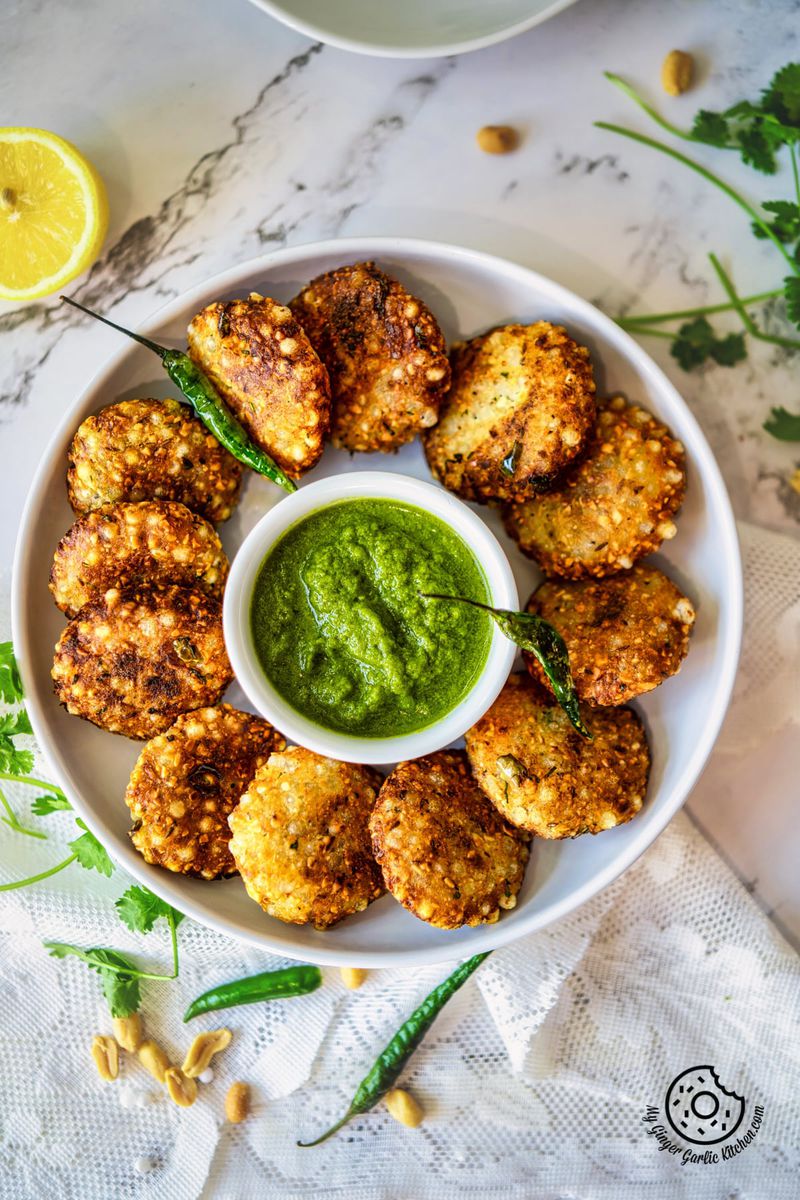
Can I air fry sabudana vada?
Yes, air-frying sabudana is possible. Air fry them at 175°C for 13 minutes, then flip and air-fry for 5 minutes at 180°C. See the detailed recipe in the recipe box.
Can I bake sabudana vada?
Absolutely, you can do that. Arrange sabudana vadas on a parchment paper-lined baking tray. Brush or spray both sides with the oil. Bake at 190°C for 30 to 35 minutes or until they are golden and crisp. You can get the detailed recipe in the recipe box.
Sabudana Vada (Fried, Baked & Air Fryer Version) (Step-by-step photo instructions)
How to Make Sabudana Vada:
- Soaking Sabudana: Add 1 cup sabudana to a bowl, and rinse it 2-3 times. Now, add 3-4 cups of water to the bowl and keep it aside for 1-2 hours.
- After 2 hours, strain the water using a colander or mesh strainer. Add sabudana again to the bowl and drizzle it with 2-3 tablespoons of water. Cover the bowl and soak the sabudana or sago for about 5-7 hours or overnight. I kept mine overnight in the refrigerator. After Soaking, check the soaked sabudana by pressing between thumb and forefinger. If they mash easily that means they are done. If you find the hard center, then add 1-2 tablespoons of water and soak for 1-2 hours.
- Boiling Potatoes: Add enough water to a pot, and then put whole potatoes in it. Boil them covered over medium heat until they are soft and cooked through. To check doneness, prick the boiled potatoes with a fork or insert a knife. If it slides gently, then they are done. Let them cool completely, and then peel the potatoes.
- Now, grate peeled potatoes using a grater and keep them aside. You can also mash them using a potato masher.
- Roasting Peanuts: Add 1/2 cups to a wide pan, and dry roast peanuts over medium heat until they are golden, crunchy, and aromatic. Keep stirring continuously to prevent them from burning. Once crispy, turn off the heat and transfer peanuts to a plate and keep it aside to cool.
- Making Peanuts Powder: Once cooled, remove the peanut skin by rubbing them between your palms. The skin would come off easily. Discard the husk and transfer them to a blender. Pulse a couple of times to make a coarse powder. You can also crush them in a mortar and pestle. Roasted peanut powder is ready, set it aside.
- Making Sabudana Vada Mixture: To a large mixing bowl, add soaked sabudana, roasted peanut powder, grated boiled potatoes, cumin seeds, chopped green chilies, ground black pepper, rock salt, sugar, and coriander leaves. Mix well to combine.
- Also, add lemon juice and knead well until it forms a dough-like ball. This mixture should be stiff so you can form the vada easily. If it doesn't come together or is sticky, then add more boiled potatoes.
- Shaping Sabudana Vada: With damp hands pinch out the lemon-sized mixture, and shape it into a smooth ball. Then flatten it between the palms to shape into a patty, keeping the edge thin. Keep shaping until all the dough is used up. Keep shaped vadas aside.
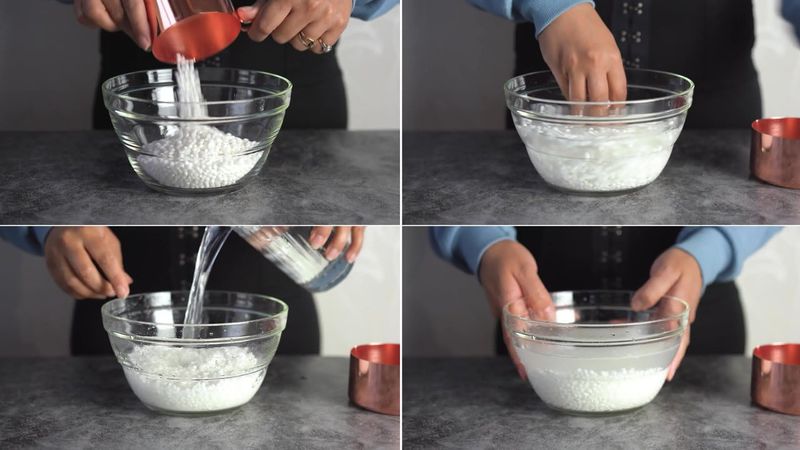
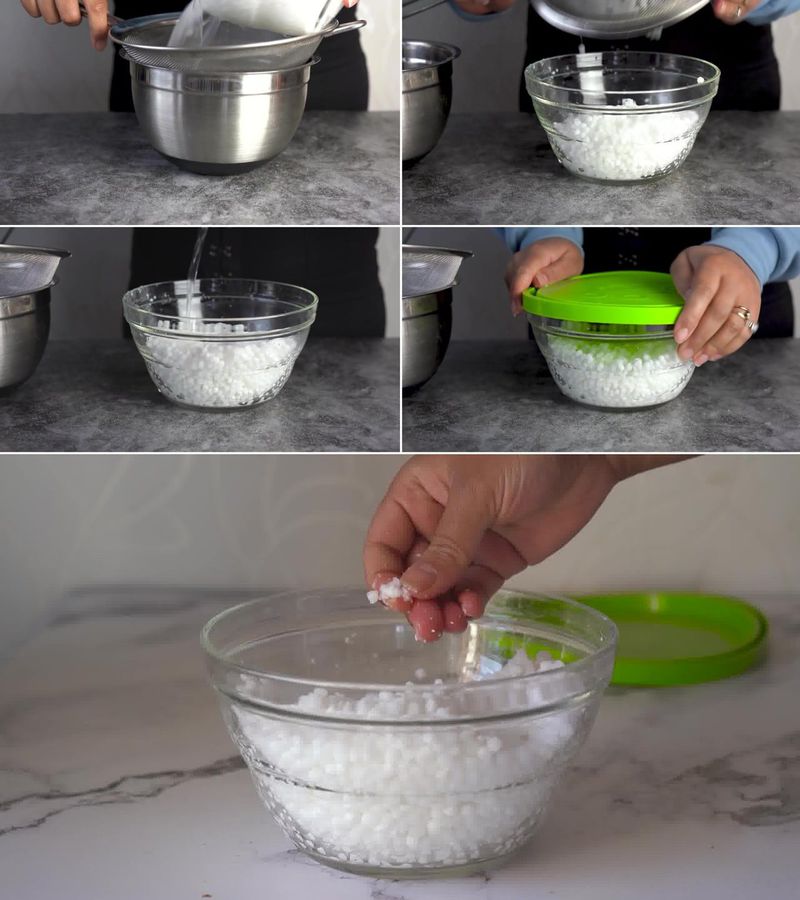
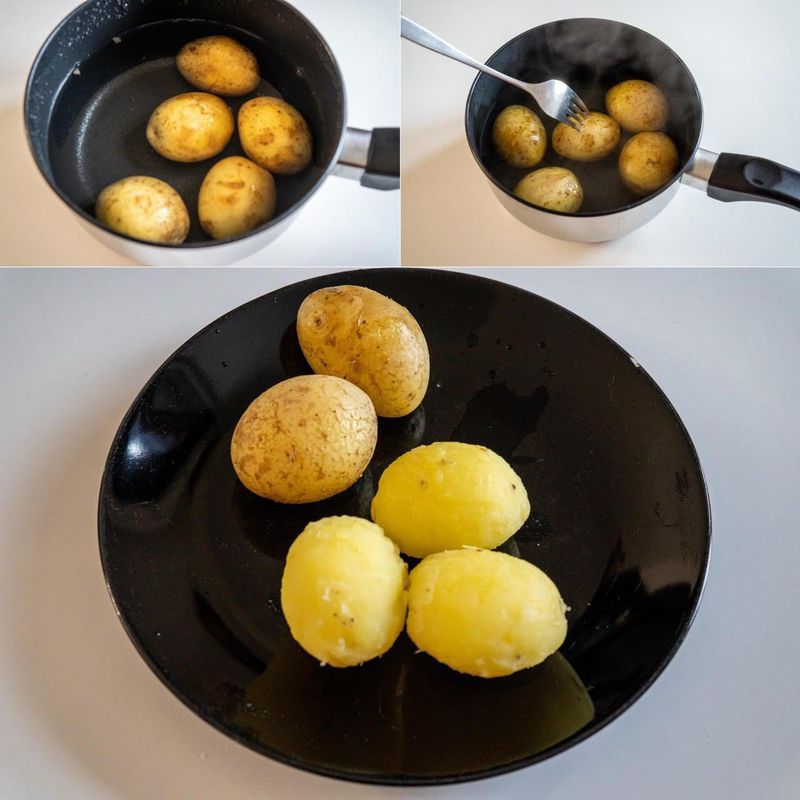
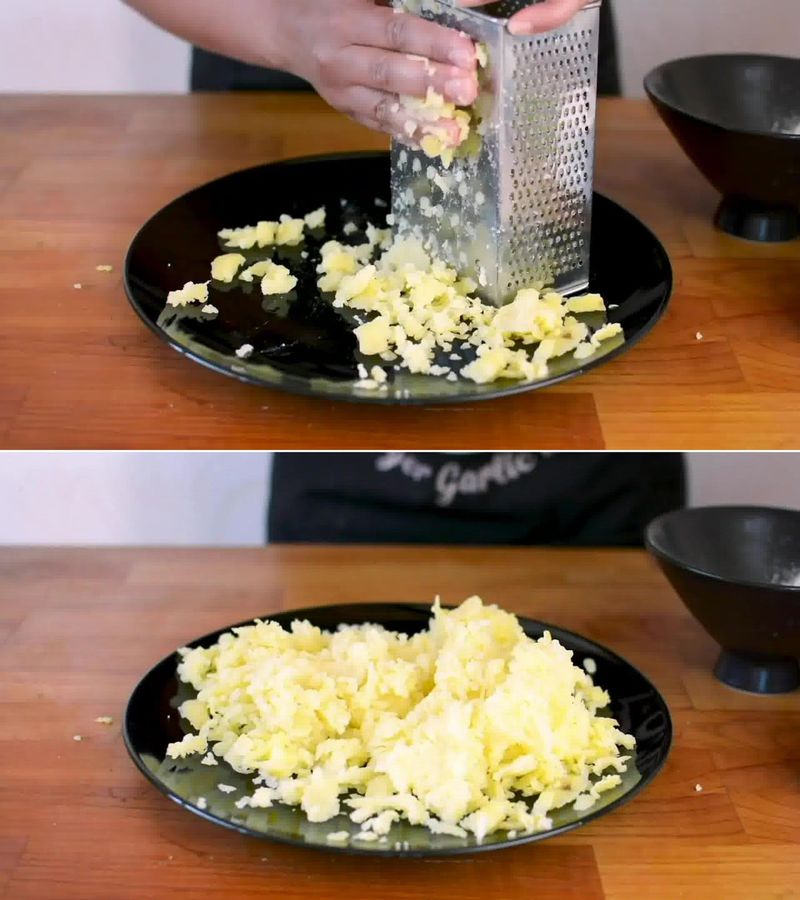
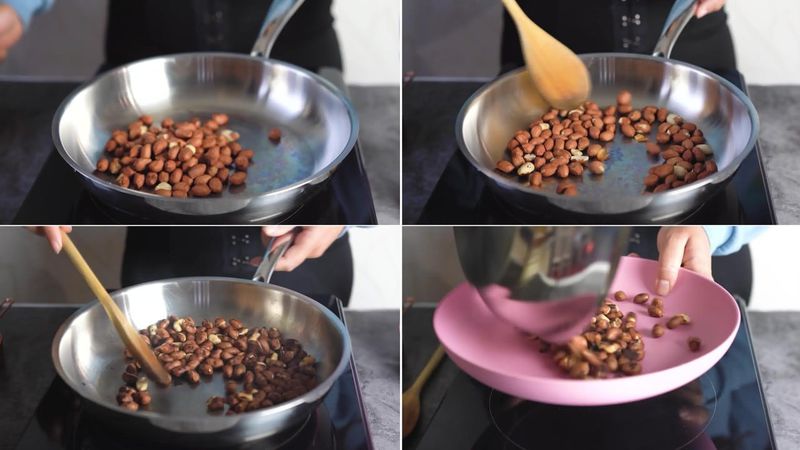
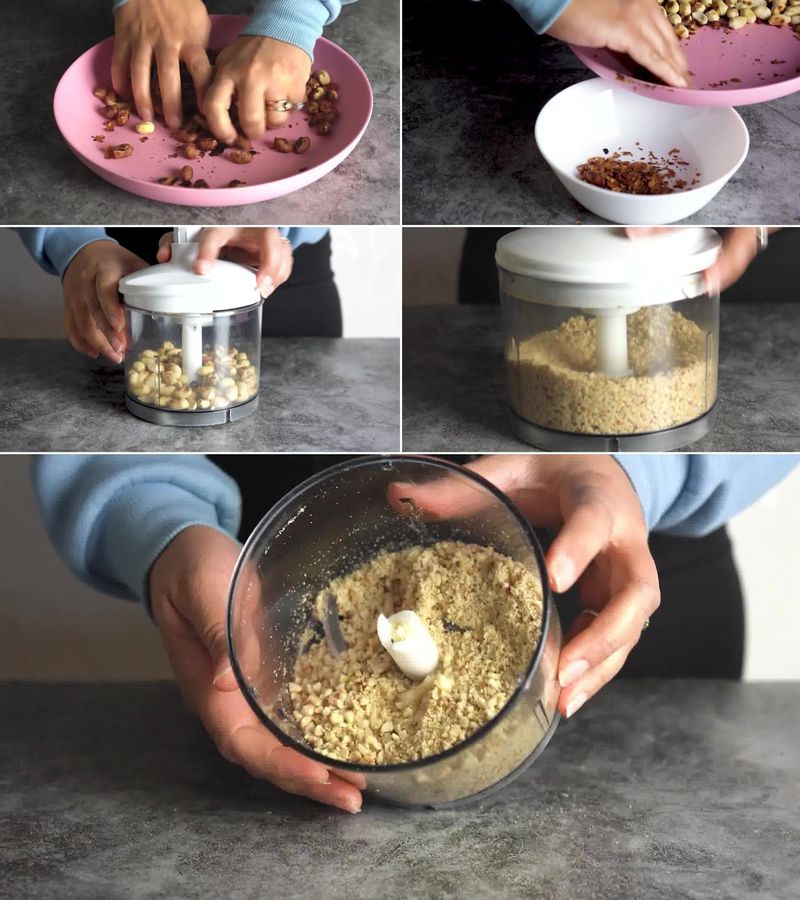
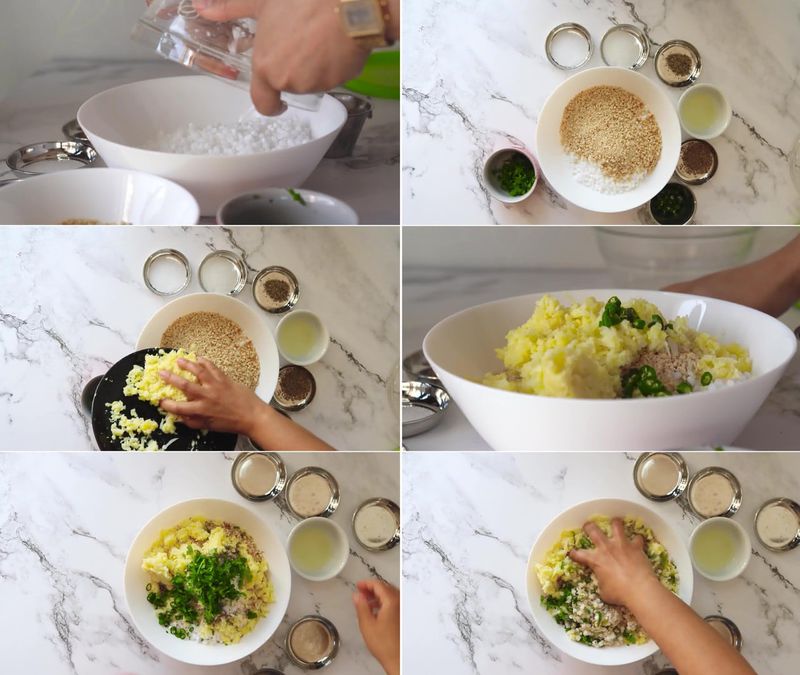
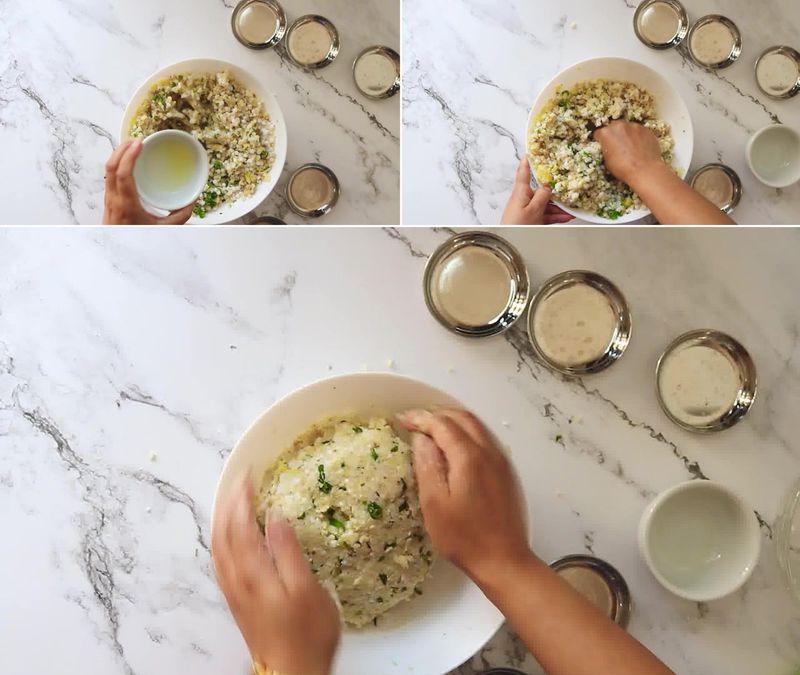
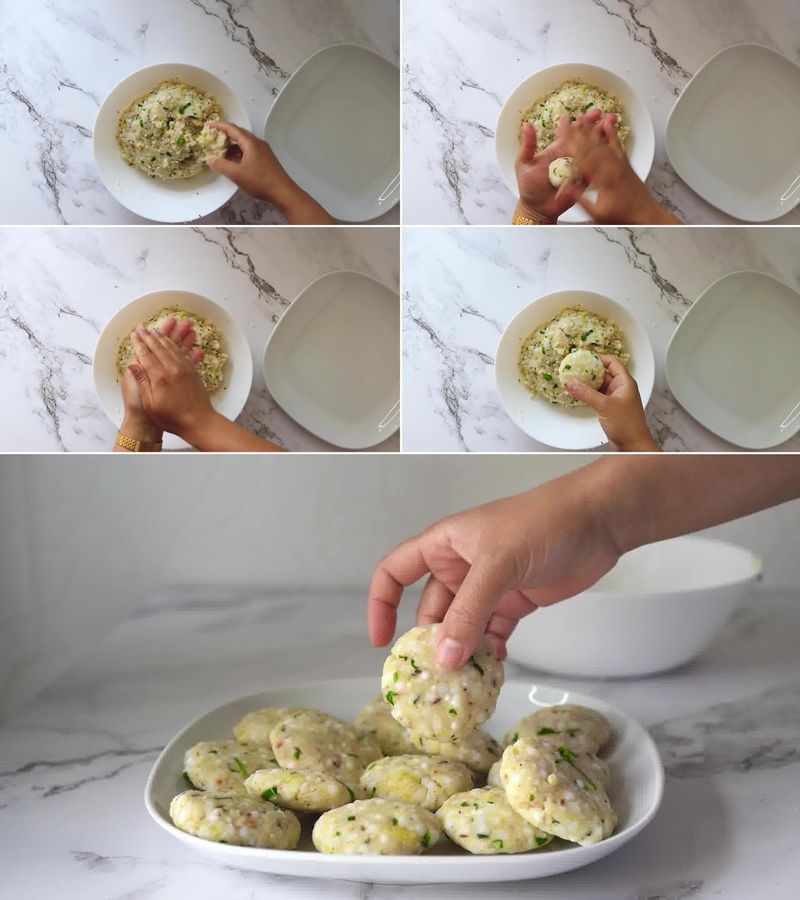
How to Fry Sabudana Vada:
- Heat enough oil in a wide pan for deep frying or shallow frying. Once hot, drop a small ball of vada mixture into the oil, and if it comes on top of steadily and sizzles then the oil is ready for frying. Turn the heat to medium and slide 4-5 vadas gently in the hot oil. Fry vadas on medium heat. Let them fry for a minute, when they turn slightly golden from one side, flip them and fry from another side. Flip a couple of times until sabudana vadas turn golden crispy and crunchy from all the sides. Once fried, remove them from the pan and transfer them on a kitchen tissue-lined plate. Repeat the frying for the rest of the vadas.
- Serving Sabudana Vada: Serve hot sabudana vada with fried green chilies, green chutney, yogurt, or tomato ketchup.

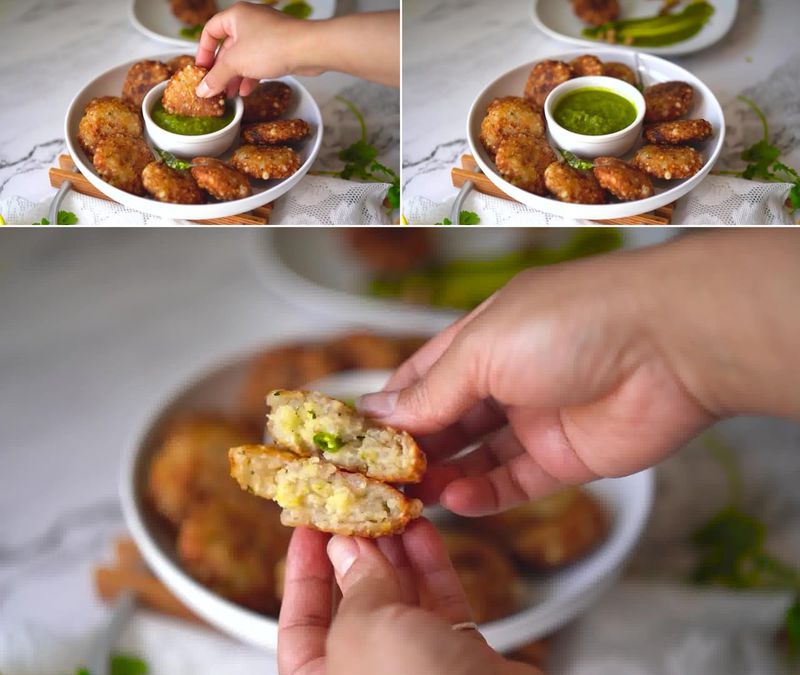
How to Air Fry Sabudana Vada:
- Place Vadas in the air fryer basket, and brush or drizzle both sides with some oil. Air fry for 13 minutes at 175°C/347°F. Once done, take out the air fryer basket and flip the vadas.
- Air fry 5 minutes at 180°C/356°F. Air fryer Sabudana Vadas are ready. Serve them hot.
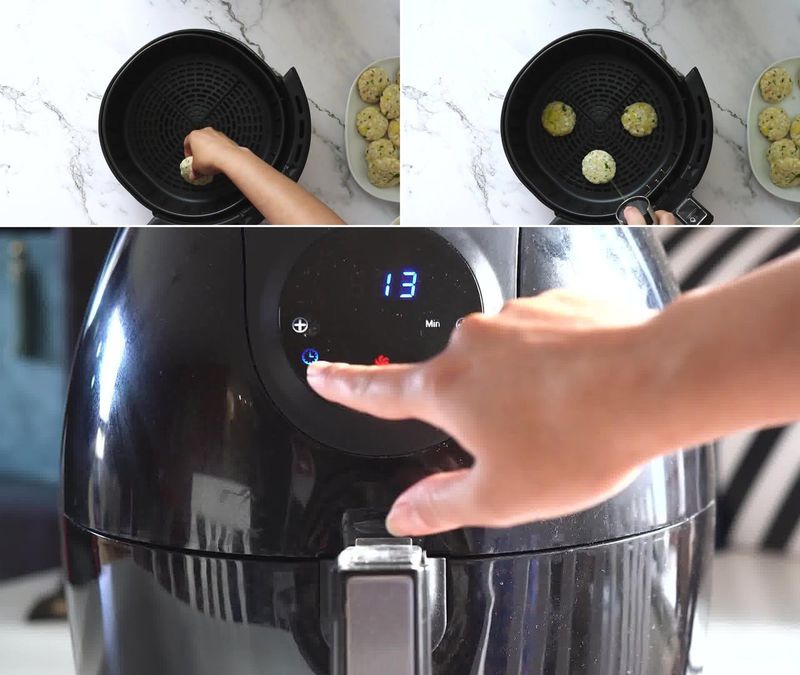
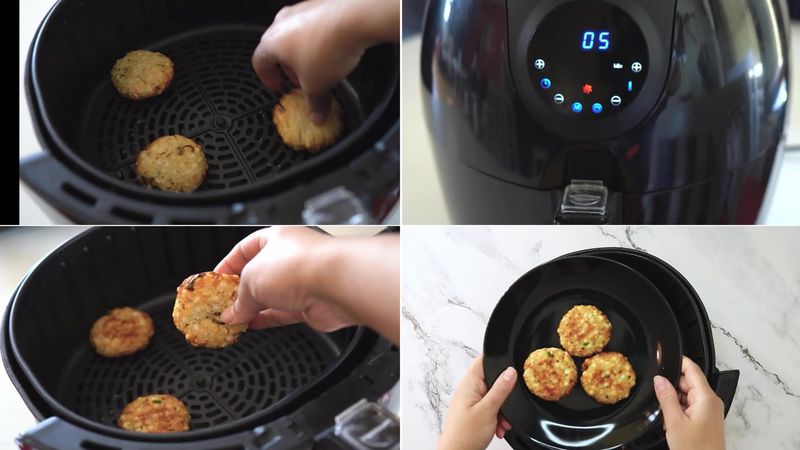
How to Bake Sabudana Vada:
- To bake sabudana vada, line a baking tray with parchment paper. Then place 4-5 vadas in the tray and brush or drizzle both sides with oil. Bake in 190°C/374°F preheated oven for about 30-35 minutes or until they turn golden and crisp.
- Remove them from the oven. Healthy Baked Sabudana Vadas are ready. Serve them hot.
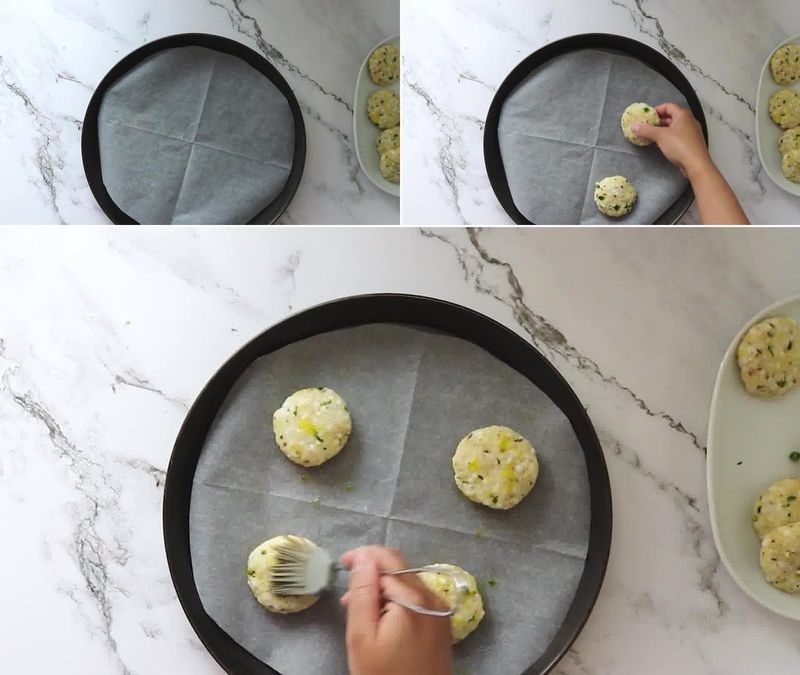
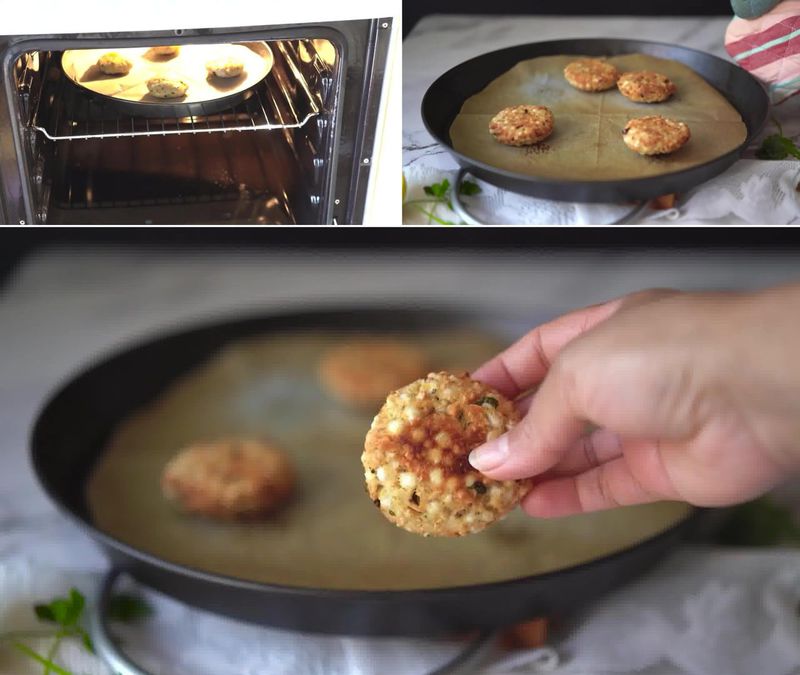
Recipe Card
Sabudana Vada (Fried, Baked & Air Fryer Version) [Recipe]
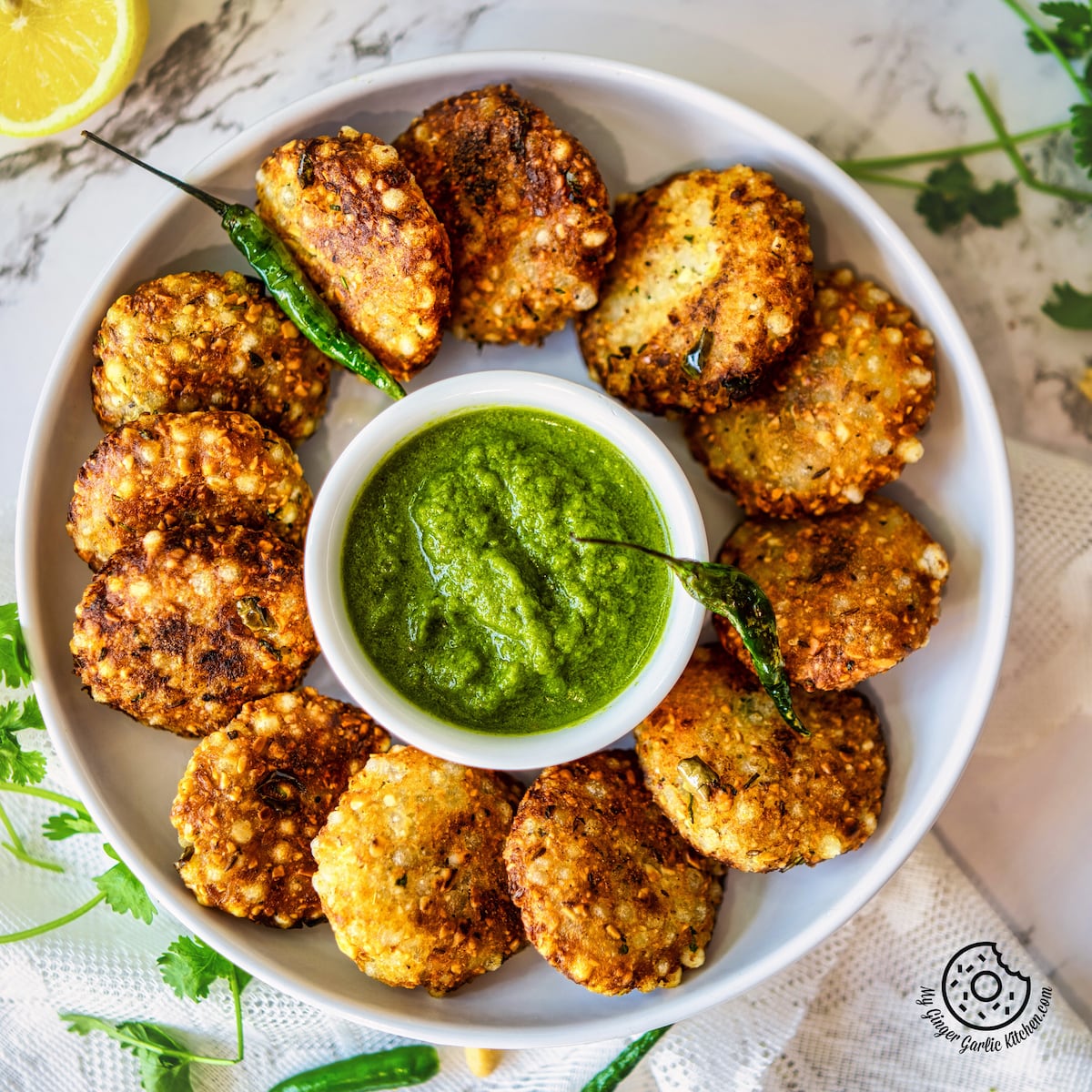
★★★★★
(Rating: 5 from 5 reviews)
| Prep time 🕐 | Cook time 🕐 | Total time 🕐 |
|---|---|---|
| 20 mins | ||
| Category ☶ | Cuisine ♨ | Serves ☺ |
| Snacks | Indian | 18-20 vadas |
| Nutrition Info ⊛ | Serving size ⊚ | |
| 80 calories | 1 vada |
INGREDIENTS
For Sabudana Vada
- 1 cup sabudana (sago or tapioca pearls)
- 3-4 medium-sized potatoes
- 1/2 cup raw peanuts
- 3-4 medium-sized green chilies, chopped (or to taste)
- 1 teaspoon cumin seeds
- 3/4 teaspoon freshly ground black pepper
- 1-2 teaspoons sugar (optional)
- Rock salt (sendha namak), to taste
- 2-3 tablespoons chopped cilantro (coriander leaves)
- 2 teaspoons lemon juice (or 1/4 teaspoon powdered citric acid)
- Oil as required, for deep frying
INSTRUCTIONS:
How to Make Sabudana Vada:
- Soaking Sabudana: Add 1 cup sabudana to a bowl, and rinse it 2-3 times. Now, add 3-4 cups of water to the bowl and keep it aside for 1-2 hours.
- After 2 hours, strain the water using a colander or mesh strainer. Add sabudana again to the bowl and drizzle it with 2-3 tablespoons of water. Cover the bowl and soak the sabudana or sago for about 5-7 hours or overnight. I kept mine overnight in the refrigerator. After Soaking, check the soaked sabudana by pressing between thumb and forefinger. If they mash easily that means they are done. If you find the hard center, then add 1-2 tablespoons of water and soak for 1-2 hours.
- Boiling Potatoes: Add enough water to a pot, and then put whole potatoes in it. Boil them covered over medium heat until they are soft and cooked through. To check doneness, prick the boiled potatoes with a fork or insert a knife. If it slides gently, then they are done. Let them cool completely, and then peel the potatoes.
- Now, grate peeled potatoes using a grater and keep them aside. You can also mash them using a potato masher.
- Roasting Peanuts: Add 1/2 cups to a wide pan, and dry roast peanuts over medium heat until they are golden, crunchy, and aromatic. Keep stirring continuously to prevent them from burning. Once crispy, turn off the heat and transfer peanuts to a plate and keep it aside to cool.
- Making Peanuts Powder: Once cooled, remove the peanut skin by rubbing them between your palms. The skin would come off easily. Discard the husk and transfer them to a blender. Pulse a couple of times to make a coarse powder. You can also crush them in a mortar and pestle. Roasted peanut powder is ready, set it aside.
- Making Sabudana Vada Mixture: To a large mixing bowl, add soaked sabudana, roasted peanut powder, grated boiled potatoes, cumin seeds, chopped green chilies, ground black pepper, rock salt, sugar, and coriander leaves. Mix well to combine.
- Also, add lemon juice and knead well until it forms a dough-like ball. This mixture should be stiff so you can form the vada easily. If it doesn't come together or is sticky, then add more boiled potatoes.
- Shaping Sabudana Vada: With damp hands pinch out the lemon-sized mixture, and shape it into a smooth ball. Then flatten it between the palms to shape into a patty, keeping the edge thin. Keep shaping until all the dough is used up. Keep shaped vadas aside.
How to Fry Sabudana Vada:
- Heat enough oil in a wide pan for deep frying or shallow frying. Once hot, drop a small ball of vada mixture into the oil, and if it comes on top of steadily and sizzles then the oil is ready for frying. Turn the heat to medium and slide 4-5 vadas gently in the hot oil. Fry vadas on medium heat. Let them fry for a minute, when they turn slightly golden from one side, flip them and fry from another side. Flip a couple of times until sabudana vadas turn golden crispy and crunchy from all the sides. Once fried, remove them from the pan and transfer them on a kitchen tissue-lined plate. Repeat the frying for the rest of the vadas.
- Serving Sabudana Vada: Serve hot sabudana vada with fried green chilies, green chutney, yogurt, or tomato ketchup.
How to Air Fry Sabudana Vada:
- Place Vadas in the air fryer basket, and brush or drizzle both sides with some oil. Air fry for 13 minutes at 175°C/347°F. Once done, take out the air fryer basket and flip the vadas.
- Air fry 5 minutes at 180°C/356°F. Air fryer Sabudana Vadas are ready. Serve them hot.
How to Bake Sabudana Vada:
- To bake sabudana vada, line a baking tray with parchment paper. Then place 4-5 vadas in the tray and brush or drizzle both sides with oil. Bake in 190°C/374°F preheated oven for about 30-35 minutes or until they turn golden and crisp.
- Remove them from the oven. Healthy Baked Sabudana Vadas are ready. Serve them hot.
WATCH RECIPE VIDEO: Click the play button and video will load ...
NOTES:
- Do not overcrowd the pan, fry only 5-6 vadas at a time.
- To make a sabudana vada recipe without potatoes, you can swap boiled potatoes with sweet potatoes or boiled raw bananas. They both work as binding agents.
- You can dry roast peanuts in a pan, oven, microwave, or in an air-fryer. When roasting peanuts in a pan, you can also add about 1 teaspoon of oil, this will make rich-tasting roasted peanuts.
- I did not use any flour for binding vadas. Potato works well as a binder in this recipe. For some reason, if your vadas are not hot holding shape or breaking while frying, then you can use some flour suitable for fasting.
- For heat I have used the combination of green chilies and black pepper. Instead of black pepper you can also add red chili powder.


